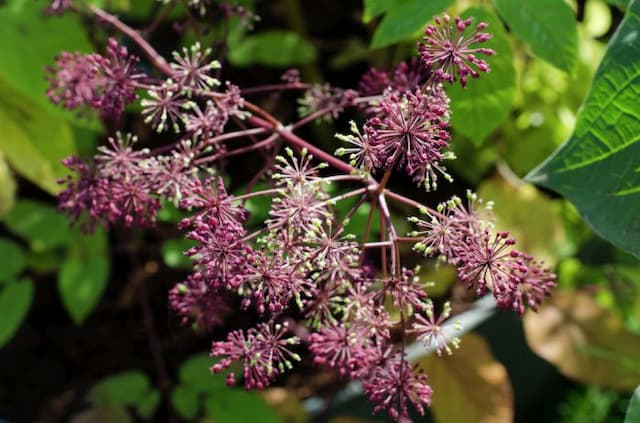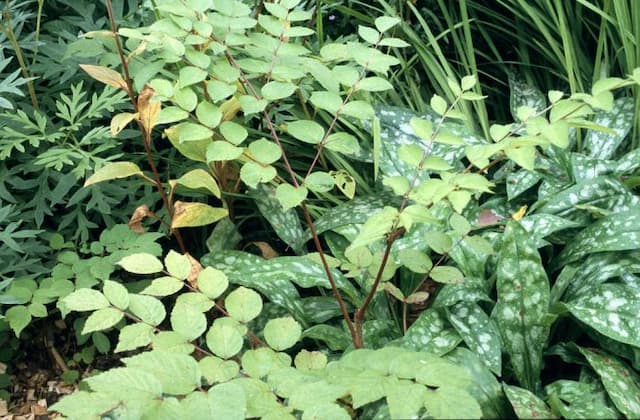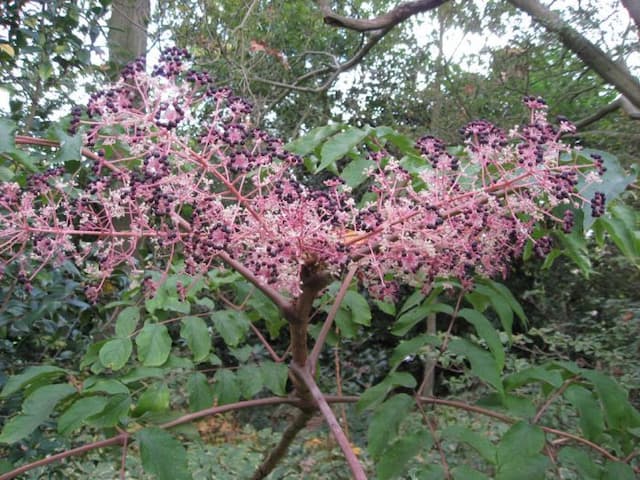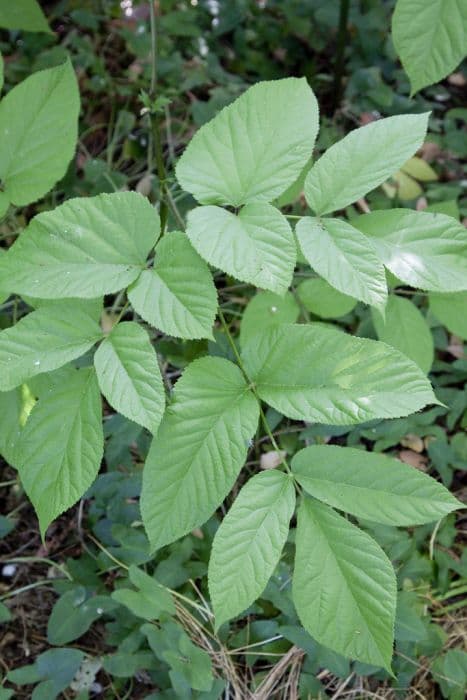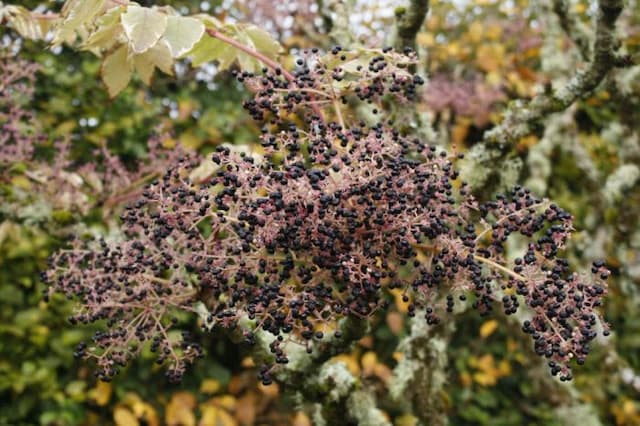Victorian Polyscias Polyscias guilfoylei 'Victoriae' (v)

ABOUT
The Victorian Aralia, known as Polyscias guilfoylei 'Victoriae' (v), boasts an exotic and elegant appearance. Its leaves are variegated with white and green, giving them a striking, almost marble-like pattern that catches the eye. Each leaf is divided into smaller leaflets, radiating out from the center of the leaf stem, much like an umbrella or a finely detailed feather. The leaflets themselves are narrow and somewhat elongated with smooth or slightly serrated edges, contributing to the plant's lush and feathery look. Moreover, this plant often has a dense, bushy growth habit, with its leaves sprouting from multiple stems, creating a full and vibrant texture. The Victorian Aralia's distinctive variegated foliage enhances its decorative appeal, making it a popular choice for indoor spaces and landscapes looking for a touch of the tropics.
About this plant
 Names
NamesFamily
Araliaceae.
Synonyms
Victorian Aralia, Geranium-leaf Aralia.
Common names
Polyscias guilfoylei 'Victoriae'
 Toxicity
ToxicityTo humans
The plant commonly known as Geranium Aralia (Polyscias guilfoylei 'Victoriae') is not typically considered toxic to humans. However, like many houseplants, it may cause mild irritation to the skin or stomach if ingested or handled without proper care. It is always recommended to keep plants out of reach of children who might chew on them, as individual reactions to plants can vary.
To pets
Geranium Aralia (Polyscias guilfoylei 'Victoriae') is not listed as a toxic plant to pets by major organizations such as the ASPCA. However, ingestion of non-food items, including any part of a houseplant, can potentially lead to mild gastrointestinal upset such as vomiting or diarrhea in pets. It is prudent to prevent pets from ingesting plants as there may be individual sensitivities, and not all potential toxins may have been identified.
 Characteristics
CharacteristicsLife cycle
Perennials
Foliage type
Evergreen
Color of leaves
Variegated
Height
4-6 feet (1.2-1.8 meters)
Spread
2-3 feet (0.6-0.9 meters)
Plant type
Shrub
Hardiness zones
10
Native area
Pacific Islands
Benefits
 General Benefits
General Benefits- Decorative Appeal: Polyscias guilfoylei 'Victoriae', also known as the 'Victoriae' Ming Aralia, boasts ornamental foliage with a mix of green and cream colors, making it a popular choice for interior decoration.
- Low Light Adaptation: It can thrive in low-light conditions, which makes it suitable for indoor environments with limited natural light.
- Humidity Tolerance: The plant is tolerant of high humidity, which is beneficial for maintaining indoor plant health in humid regions or bathrooms.
- Compact Growth: Ming Aralia has a compact and upright growth habit, which allows it to fit well in small spaces without requiring extensive pruning.
- Easy to Shape: The plant's growth pattern allows for easy shaping and pruning to create topiaries or other decorative forms.
- Thermal Regulation: Like other plants, it contributes to regulating temperature by absorbing heat, which can slightly cool surrounding areas.
- Acoustic Benefits: The plant's foliage can help to dampen noise, thus contributing to a more tranquil environment.
- Stress Reduction: The presence of greenery like Ming Aralia in indoor settings is known to reduce stress and promote a sense of well-being.
- Easy Propagation: It can be easily propagated from cuttings, enabling gardeners to create new plants for additional spaces or as gifts.
 Medical Properties
Medical PropertiesThis plant is not used for medical purposes.
 Air-purifying Qualities
Air-purifying QualitiesThis plant is not specifically known for air purifying qualities.
 Other Uses
Other Uses- Polyscias guilfoylei 'Victoriae', commonly known as variegated aralia, can be used in miniature gardens and fairy gardens due to its small and intricate foliage, which adds a touch of whimsical realism to these imaginative spaces.
- The plant's unique aesthetic with variegated leaves makes it well-suited for artistic photography, often used as a subject or backdrop in botanical photography to create visually striking images.
- Variegated aralia leaves can be utilized in scrapbooking and papermaking for their decorative patterns, often pressed and dried to be used as ornamental elements in crafts.
- In fashion, elements of the plant have been used as inspiration for textile designs, where its foliage pattern offers a natural and organic look for fabric prints.
- Its sturdy stems can be used in model making, especially for architectural models, to simulate trees and large shrubs, adding a realistic touch to scale representations.
- The plant can be trained and pruned into intricate shapes, making it suitable for the art of topiary, where it can serve as a living sculpture in gardens and landscapes.
- In educational settings, the variegated aralia can be used to teach principles of pruning and plant care, as it responds well to trimming and can demonstrate regrowth patterns.
- The contrasting leaf colors of the variegated aralia make it useful in color theory studies for artists and designers, as a real-life example of how different hues interact.
- Its leaves can be infused in water to create a natural dye for textiles or paper, although not commonly practiced, offering a subtle range of colors derived from the plant's pigments.
- The bark and wood of mature variegated aralia plants may be used in woodworking projects for ornamental pieces, though this is not a typical application due to the plant's usual small size in cultivation.
Interesting Facts
 Feng Shui
Feng ShuiThe Panax is not used in Feng Shui practice.
 Zodiac Sign Compitability
Zodiac Sign CompitabilityThe Panax is not used in astrology practice.
 Plant Symbolism
Plant Symbolism- Adaptability: Due to its resilience and ability to thrive in various indoor conditions, the Polyscias guilfoylei 'Victoriae', commonly known as the Variegated Aralia, symbolizes adaptability.
- Diversity: The varied leaf patterns and colors of the Variegated Aralia can represent the beauty of diversity and variety in life.
- Protection: In some cultures, the Aralia plant is believed to ward off negative energy, symbolizing protection.
- Growth: As a plant that can be pruned and shaped in many forms, the Variegated Aralia symbolizes personal growth and the ability to adapt to life's changes.
 Water
WaterThe Victorian Aralia should be watered when the top inch of soil feels dry to the touch. It generally requires watering approximately once a week, but this can vary depending on the humidity and temperature of the environment. Be sure to water thoroughly, allowing water to drain out of the bottom of the pot, and then remove any excess water from the saucer, as standing water can lead to root rot. A good rule of thumb is to provide approximately half a gallon of water every week, adjusting as needed for your plant's specific conditions.
 Light
LightThe Victorian Aralia thrives in bright, indirect light but can tolerate some partial shade. It should not be exposed to direct sunlight, as this can scorch the leaves. The ideal spot for this plant is near a window with a sheer curtain, providing filtered sunlight throughout the day. Avoid placing it in very dark corners or in direct, harsh afternoon sun.
 Temperature
TemperatureThe Victorian Aralia prefers a temperature range of 60 to 85 degrees Fahrenheit and should not be exposed to temperatures below 55 degrees, as this can cause harm to the plant. The ideal growing conditions include a stable indoor temperature that doesn’t fluctuate significantly, avoiding cold drafts and direct heat sources.
 Pruning
PruningPrune the Victorian Aralia to maintain its shape and encourage lush, healthy growth. It is preferable to prune lightly in the spring or early summer when the plant is entering a period of active growth. Removing dead or yellowing leaves, as well as any leggy branches, can be done as needed to keep the plant looking tidy. Pruning should be done with clean, sharp scissors or pruning shears to make clean cuts.
 Cleaning
CleaningAs needed
 Soil
SoilFor Geranium Aralia (Polyscias guilfoylei 'Victoriae'), use a well-draining soil mix composed of two parts peat, one part perlite, and one part pine bark. This plant prefers a slightly acidic to neutral pH, roughly between 6.0 and 7.5.
 Repotting
RepottingGeranium Aralia should be repotted every two to three years, or when it becomes root-bound. Spring is typically the best time to repot this plant for optimal growth.
 Humidity & Misting
Humidity & MistingGeranium Aralia thrives in high humidity conditions, ideally between 40% to 60%. Regular misting or a humidity tray can help maintain these levels indoors.
 Suitable locations
Suitable locationsIndoor
Place in bright, indirect light; keep soil moist but not waterlogged.
Outdoor
Provide dappled shade; protect from strong winds and frost.
Hardiness zone
11-12 USDA
 Life cycle
Life cyclePolyscias guilfoylei 'Victoriae', commonly known as the Victorian Polyscias, begins its life cycle with seed germination, where environmental conditions such as warmth and moisture trigger the development of the embryonic plant contained within the seed. Following germination, the seedling emerges and establishes itself, developing a root system and simple leaves for photosynthesis. The plant then enters the vegetative growth phase, characterized by rapid leaf and stem growth, during which it can be shaped and pruned into desired forms, often being used as an ornamental plant. As it matures, the Victorian Polyscias can produce small flowers, although flowering is generally infrequent and inconspicuous in this species. After the rare event of pollination and fertilization, it may produce seeds, thereby completing the reproductive cycle. Throughout its life, Victorian Polyscias requires consistent care, including appropriate light, water, and humidity conditions, to thrive and may live for many years with proper maintenance.
 Propogation
PropogationPropogation time
Spring-Early Summer
Propogation: For the Victorian Aralia (Polyscias guilfoylei 'Victoriae'), the most popular method of propagation is through stem cuttings. This technique is generally performed during the warmer months, such as late spring through early summer, when the plant is actively growing. To propagate, a gardener would select a healthy stem and make a cutting of about 4 to 6 inches (approximately 10 to 15 cm) long, ensuring that there are at least a couple of leaf nodes present. The lower leaves are removed and the cut end may be dipped in rooting hormone to encourage root development. The cutting should then be placed in a well-draining potting mix or a propagation medium such as perlite or vermiculite, and kept under high humidity and indirect light until roots have formed, which can take several weeks. Once rooted, the new Victorian Aralia plants can be potted up into individual containers and gradually acclimated to less humid conditions.


